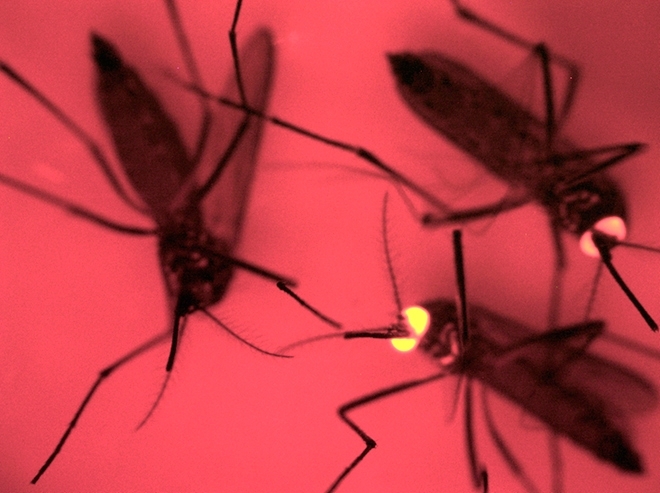

Male specimens with defective sperm created in Brazilian lab may be used to reduce Aedes aegypti population, participating in coordinated strategies to control dengue, chikungunya, Zika and yellow fever epidemics (photo: Sterile Aedes aegypti mosquitoes. Fluorescent marker shows insertion of “sterility conditional construct” [SCC] that results in sperm-defective mosquito. Normal wild mosquito shown on left [without fluorescent marker] / strains obtained by Danilo Oliveira Carval
Male specimens with defective sperm created in Brazilian lab may be used to reduce Aedes aegypti population, participating in coordinated strategies to control dengue, chikungunya, Zika and yellow fever epidemics.
Male specimens with defective sperm created in Brazilian lab may be used to reduce Aedes aegypti population, participating in coordinated strategies to control dengue, chikungunya, Zika and yellow fever epidemics.

Male specimens with defective sperm created in Brazilian lab may be used to reduce Aedes aegypti population, participating in coordinated strategies to control dengue, chikungunya, Zika and yellow fever epidemics (photo: Sterile Aedes aegypti mosquitoes. Fluorescent marker shows insertion of “sterility conditional construct” [SCC] that results in sperm-defective mosquito. Normal wild mosquito shown on left [without fluorescent marker] / strains obtained by Danilo Oliveira Carval
By José Tadeu Arantes | Agência FAPESP – Alongside the development of vaccines, the production of genetically modified mosquitoes could become one of the most effective means of combating epidemics of dengue, chikungunya, Zika and yellow fever.
Transgenic males of Aedes aegypti with defective sperm have been created at the University of São Paulo’s Biomedical Science Institute (ICB-USP) in Brazil and may be produced on a pilot scale in the course of next year.
“These GM males mate with wild females wherever they can, including places that aren’t accessible to human action. Owing to the defect introduced into their sperm, the eggs that result from their mating are nonviable, and this helps reduce the population of A. aegypti,” said Margareth Capurro, a professor at ICB-USP and principal investigator for the project based on the use of transgenic mosquito lines.
Capurro stressed that this should not be the only strategy deployed to combat the diseases in question. It should be one of a battery of coordinated control measures ranging from education of the public to the development of vaccines, the use of larvicides and insecticides, and the adequate treatment of breeding grounds such as garbage dumps, tires and other water containers.
“This GM mosquito is a Brazilian product,” she said. “Its development was funded by FAPESP and the International Atomic Energy Agency [IAEA, the UN’s nuclear watchdog]. So instead of being appropriated by some private-sector company with a profit motive, it should be distributed free of charge by the UN to the 44 countries involved in mosquito control. I’ve also argued that it shouldn’t be patented. The technology should be donated to any country that wants to use it.”
According to Capurro, Phase 1 of the project was completed with production of the mosquito in ICB-USP’s laboratories.
“Next summer, we embark on Phase 2, consisting of field cage tests. The mosquitoes will be confined in large cages with an area of 3 square meters immersed in a natural environment. The aim is to find out whether they can survive and mate in the presence of wind and rain. This is an important test, as genetic modification can induce undesirable traits as well as the traits of interest,” said Capurro, who leads the research project “Improvement and evaluation of Aedes aegypti transgenic lines to control dengue transmission”, supported by FAPESP.
Phase 2 will be conducted at Moscamed Brasil’s biofactory in Juazeiro, Bahia State. This partner institution is a nonprofit established under the aegis of the IAEA’s program to develop sterile strains of the Mediterranean fruit fly (mosca means fly in at least three languages spoken in the region). The program has already inspired the creation of several biofactories to produce transgenic insects around the world.
Pilot-scale production
The mosquito’s life cycle lasts 30 days. Phase 2 will involve the breeding of several generations and the evaluation of each one, so it will take six to eight months, approximately from September 2018 to March or April 2019.
If all goes well, Phase 3 should begin in late 2019 or early 2020, seeing pilot-scale production of some 500,000 GM mosquitoes per week.
In this phase, a number of adjustments may be made to the product. The next step will be large-scale implementation of the strategy. To this end, the Juazeiro biofactory already has the installed capacity to produce 14 million GM mosquitoes per week.
“But production at Juazeiro or elsewhere depends on several logistical conditions, such as production cost, transportation cost, hiring and training qualified personnel, and so on,” Capurro said. “I intend to deliver the technology ready for use to the Health Ministry and other ministries. They can set up a program to implement it if they see fit. The product will also be delivered to the UN, so even if Brazil decides not to implement a program, other countries can do so.”
Republish
The Agency FAPESP licenses news via Creative Commons (CC-BY-NC-ND) so that they can be republished free of charge and in a simple way by other digital or printed vehicles. Agência FAPESP must be credited as the source of the content being republished and the name of the reporter (if any) must be attributed. Using the HMTL button below allows compliance with these rules, detailed in Digital Republishing Policy FAPESP.





